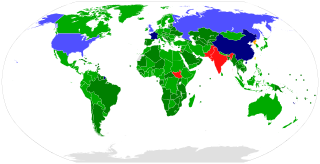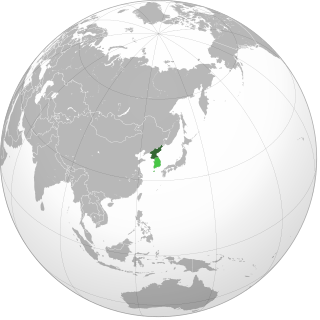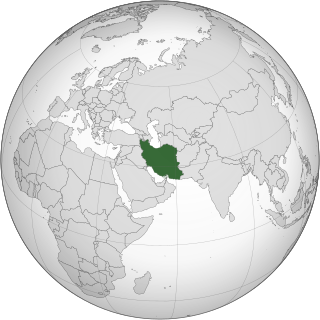Related Research Articles

The Treaty on the Non-Proliferation of Nuclear Weapons, commonly known as the Non-Proliferation Treaty or NPT, is an international treaty whose objective is to prevent the spread of nuclear weapons and weapons technology, to promote cooperation in the peaceful uses of nuclear energy, and to further the goal of achieving nuclear disarmament and general and complete disarmament. Between 1965 and 1968, the treaty was negotiated by the Eighteen Nation Committee on Disarmament, a United Nations-sponsored organization based in Geneva, Switzerland.

Nuclear proliferation is the spread of nuclear weapons, fissionable material, and weapons-applicable nuclear technology and information to nations not recognized as "Nuclear Weapon States" by the Treaty on the Non-Proliferation of Nuclear Weapons, commonly known as the Non-Proliferation Treaty or NPT. Proliferation has been opposed by many nations with and without nuclear weapons, as governments fear that more countries with nuclear weapons will increase the possibility of nuclear warfare, de-stabilize international or regional relations, or infringe upon the national sovereignty of nation states.

North Korea has a military nuclear weapons program and, as of early 2020, is estimated to have an arsenal of approximately 30 to 40 nuclear weapons and sufficient production of fissile material for six to seven nuclear weapons per year. North Korea has also stockpiled a significant quantity of chemical and biological weapons. In 2003, North Korea withdrew from the Treaty on the Non-Proliferation of Nuclear Weapons (NPT). Since 2006, the country has conducted six nuclear tests at increasing levels of expertise, prompting the imposition of sanctions.
Iran has several research sites, two uranium mines, a research reactor, and uranium processing facilities that include three known uranium enrichment plants.

Natanz is a city in the Central District of Natanz County, Isfahan province, Iran, and serves as both capital of the county and of the district. It is 70 kilometres (43 mi) south-east of Kashan.

South Korea has the raw materials and equipment to produce a nuclear weapon. However, it has not opted to make one. South Korea has continued on a stated policy of non-proliferation of nuclear weapons since 2004 and has adopted a policy to maintain a nuclear-free Korean Peninsula. By contrast, North Korea has and is developing additional nuclear weapons.

Iran is not known to currently possess weapons of mass destruction (WMD) and has signed treaties repudiating the possession of WMDs including the Biological Weapons Convention, the Chemical Weapons Convention, and the Non-Proliferation Treaty (NPT). Iran has first-hand knowledge of WMD effects—over 100,000 Iranian troops and civilians were victims of chemical weapons during the 1980s Iran–Iraq War.
Alireza Jafarzadeh is an Iranian dissident, media commentator on the Middle East, and US representative of the People's Mujahedin of Iran. He is known for releasing information on Iran's secret nuclear program.
A nuclear fuel bank is reserve of low enriched uranium (LEU) for countries that need a backup source of LEU to fuel their nuclear reactors. Countries that do have enrichment technology would donate enriched fuel to a "bank", from which countries not possessing enrichment technology would obtain fuel for their power reactors.

United Nations Security Council Resolution 1747 was a United Nations Security Council resolution, written with reference to some IAEA reports, that tightened the sanctions imposed on Iran in connection with the Iranian nuclear program. It was adopted unanimously by the United Nations Security Council on 24 March 2007.
This is the timeline of the nuclear program of Iran.

Saudi Arabia is not known to have a nuclear weapons program. From an official and public standpoint, Saudi Arabia has been an opponent of nuclear weapons in the Middle East, having signed the Treaty on the Non-Proliferation of Nuclear Weapons, and is a member of the coalition of countries demanding a Nuclear-weapon-free zone in the Middle East. Studies of nuclear proliferation have not identified Saudi Arabia as a country of concern. Nuclear technology company IP3 International was formed in June 2016 to transfer nuclear technology from the United States to Saudi Arabia.

The 2010 Nuclear Security Summit was a summit held in Washington, D.C., on April 12 and 13, 2010. The Summit focused on how to better safeguard weapons-grade plutonium and uranium to prevent nuclear terrorism.
Events in the year 2010 in the Islamic Republic of Iran.
Views on the nuclear program of Iran vary greatly, as the nuclear program of Iran is a very contentious geopolitical issue. Uriel Abulof identifies five possible rationales behind Iran’s nuclear policy: (i) Economy, mainly energy needs; (ii) Identity politics, pride and prestige; (iii) Deterrence of foreign intervention; (iv) Compellence to boost regional influence; and (v) Domestic politics, mitigating, through 'nuclear diversion' the regime’s domestic crisis of legitimacy. Below are considerations of the Iranian nuclear program from various perspectives.
On 24 November 2013, the Joint Plan of Action, also known as the Geneva interim agreement, was a pact signed between Iran and the P5+1 countries in Geneva, Switzerland. It consists of a short-term freeze of portions of Iran's nuclear program in exchange for decreased economic sanctions on Iran, as the countries work towards a long-term agreement. It represented the first formal agreement between the United States and Iran in 34 years. Implementation of the agreement began 20 January 2014.

The Joint Comprehensive Plan of Action, commonly known as the Iran nuclear deal or Iran deal, is an agreement on the Iranian nuclear program reached in Vienna on 14 July 2015, between Iran and the P5+1 together with the European Union.

The Iran nuclear deal framework was a preliminary framework agreement reached in 2015 between the Islamic Republic of Iran and a group of world powers: the P5+1 and the European Union.
Fordow Fuel Enrichment Plant (FFEP) is an Iranian underground uranium enrichment facility located 20 miles (32 km) northeast of the Iranian city of Qom, near Fordow village, at a former Islamic Revolutionary Guard Corps base. The site is under the control of the Atomic Energy Organization of Iran (AEOI). It is the second Iranian uranium enrichment facility, the other one being that of Natanz. According to the Institute for Science and International Security, possible coordinates of the facility's location are: 34.88459°N 50.99596°E.
2021 Natanz incident refers to a suspected attack on the Natanz nuclear site in Iran. The Natanz nuclear facility is placed in the wilderness in the central province of Isfahan, Iran. This site is scouted by the International Atomic Energy Agency (IAEA), the U.N. nuclear watchdog.
References
- ↑ "Iran says it owns more uranium than needed". Aljazeera . 18 November 2014.
- ↑ "Irans larijani positive about tehran west talks". The Iran Report.